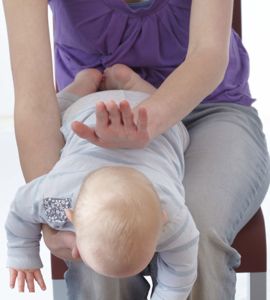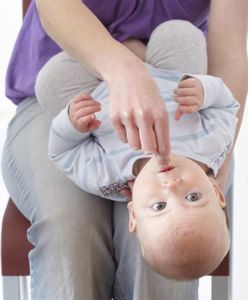 A survey commissioned to mark the publication of the latest edition of the DK First Aid Manual, written and authorised by the UK’s three leading first aid providers, St John Ambulance, St Andrew’s First Aid and the British Red Cross, reveals that a third of parents have been in a situation where their child has started choking and worryingly, only half of parents did not know the correct procedure. Here we have the new infant choking technique and guidelines.
A survey commissioned to mark the publication of the latest edition of the DK First Aid Manual, written and authorised by the UK’s three leading first aid providers, St John Ambulance, St Andrew’s First Aid and the British Red Cross, reveals that a third of parents have been in a situation where their child has started choking and worryingly, only half of parents did not know the correct procedure. Here we have the new infant choking technique and guidelines.
An infant is more likely to choke on food or small objects than an adult. The infant will rapidly become distressed, and you need to act quickly to clear any obstruction. If the infant loses consciousness, the throat muscles may relax and the airway may open enough to do rescue breathing. Be prepared to begin rescue breaths and chest compressions.
 1. If the infant is distressed, is unable to cry, cough or breathe, lay her face down along your thigh and support her head. Give up to five back blows between the shoulder blades, with the heel of your hand.
1. If the infant is distressed, is unable to cry, cough or breathe, lay her face down along your thigh and support her head. Give up to five back blows between the shoulder blades, with the heel of your hand.
2. Turn the infant over so that she is face up along your other leg and check her mouth. Remove any obvious obstructions with your fingertips. Do not sweep the mouth with your finger as this may push the object further down the throat.
3. If back blows fail to clear the obstruction, try chest thrusts. With the infant lying face up along your leg, place two fingers on the lower part of the breastbone one finger’s breadth below the nipple line, and push inwards and downwards, towards the head.
 4. Perform up to five chest thrusts. The aim is to relieve the obstruction with each chest thrust rather than necessarily doing all five.
4. Perform up to five chest thrusts. The aim is to relieve the obstruction with each chest thrust rather than necessarily doing all five.
5. Check the mouth. If the obstruction still has not cleared, repeat steps 1 to 4 three times.
6. If the obstruction still has not cleared, take the infant with you to call 999/112 for emergency help. Continue until help arrives or the infant loses consciousness (see rescue breathing above).
Instructions and images taken from the First Aid Manual (10th edition), published by DK.
